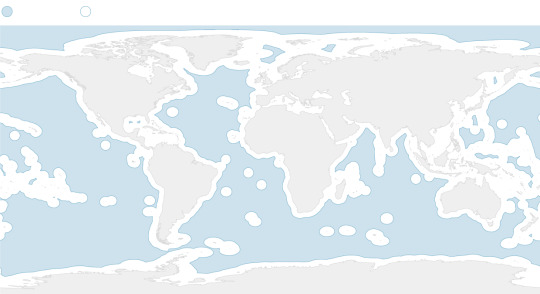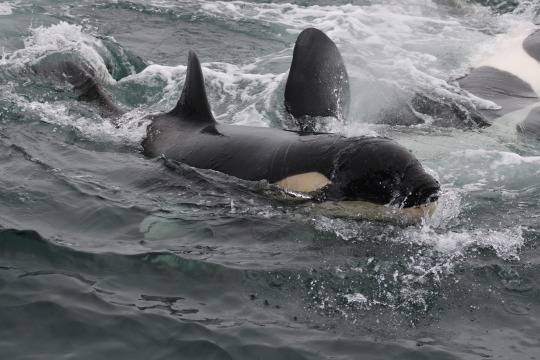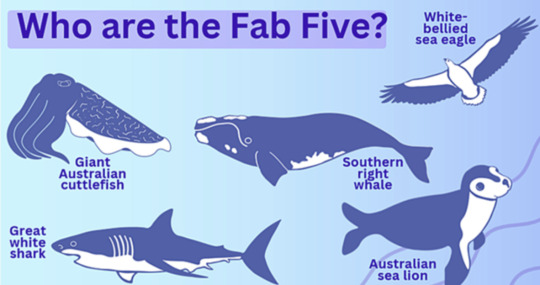#Marine Protected Areas
Explore tagged Tumblr posts
Text
Excerpt from this story from Inside Climate News:
Many existing marine protected areas might be something like screen doors on a submarine, at least as far as their impact on ocean conservation.
A new study finds that only a third of the world’s largest marine protected areas (MPAs) currently implement meaningful conservation measures.
Increasingly, marine conservation is the art of separating humans from parts of the ocean. More often than not, marine protected areas, swaths of the sea that are set aside and managed to preserve sea life and its habitats, are the flagship models for government efforts to accomplish this.
However, a recent analysis published in Conservation Letters revealed alarming inadequacies in the effectiveness of the world’s largest MPAs. The study, conducted by an international group of researchers spearheaded by the Marine Conservation Institute in Seattle, Washington, focused on the largest 100 MPAs in the world, which together encompass over 7 percent of the world’s ocean area.
“There are 18,000 MPAs, but a hundred of them make up 90 percent of the area,” said Beth Pike, director of the Marine Protection Atlas and the study’s lead author. “These are the big needle movers.”
Pike and her colleagues found only a third of these MPAs’ total expanse to be under high or full protection—just 2.6 percent of the global ocean footprint. They found another third of these MPAs’ territories allowed for destructive activities, such as mining and industrial fishing, making them inherently incompatible with conservation. Additionally, another quarter of the protected area they analyzed were deemed “paper parks,” meaning that while these ocean spaces had been officially proposed or designated as MPAs, they had yet to implement any subsequent conservation measures. For example, over 60 percent of the OSPAR MPA network, which jointly covers roughly 7 percent of the Northeast Atlantic Ocean, appears to have benefited from no protection activities aside from its listing as a protected area.
These findings stand in stark contrast with the agreement by 188 governments to protect 30 percent of the world’s lands and waters by 2030—the 30×30 initiative—in the Kunming-Montreal Global Biodiversity Framework adopted during the United Nations Biodiversity Conference (COP15), in December 2022.
13 notes
·
View notes
Text
It has been almost two decades in the making, but late on Saturday night in New York, after days of gruelling round-the-clock talks, UN member states finally agreed on a treaty to protect the high seas.
A full day after the deadline for talks had officially passed, the conference president, Rena Lee of Singapore, took to the floor of room 2 of the UN headquarters in New York and announced that the treaty had been agreed. At a later date, the delegates will meet for half a day to formally adopt the text. She made it clear the text would not be reopened.
“In Singapore, we like to go on learning journeys, and this has been the learning journey of a lifetime,” Lee said.
She thanked delegates for their dedication and commitment. “The success is also yours,” she told them.
She received cheers and a standing ovation from delegates in the room who had not left the conference hall for two days and worked through the night in order to get the deal done.

Pictured: The Intergovernmental Conference on Biodiversity Beyond National Jurisdiction congratulating its President, Ambassador Rena Lee, on the successful conclusion of the BBNJ treaty.
The historic treaty is crucial for enforcing the 30x30 pledge made by countries at the UN biodiversity conference in December, to protect a third of the sea (and land) by 2030. Without a treaty, this target would certainly fail, as until now no legal mechanism existed to set up MPAs [Marine Protected Areas] on the high seas.
Ocean ecosystems produce half the oxygen we breathe, represent 95% of the planet’s biosphere and soak up carbon dioxide, as the world’s largest carbon sink. Yet until now, fragmented and loosely enforced rules governing the high seas have rendered this area more susceptible than coastal waters to exploitation.
Veronica Frank, political adviser for Greenpeace, said that while the organisation hadn’t seen the latest text, “We are really happy. The world is so divided and to see multilateralism supported is so important.
“What’s really important is now to use this tool to develop this 30x30 target into force really quickly.” ...

Pictured: Activists from Greenpeace display a banner before the United Nations headquarters during ongoing negotiations at the UN on a treaty to protect the high seas in New York
“High seas marine protected areas can play a critical role in the impacts of climate change,” said Liz Karan, director of Pew’s ocean governance project. “Governments and civil society must now ensure the agreement is adopted and rapidly enters into force and is effectively implemented to safeguard high seas biodiversity.”
The High Ambition Coalition �� which includes the EU, US, UK and China – were key players in brokering the deal, building coalitions instead of sowing division and showing willingness to compromise in the final days of talks. The Global South led the way in ensuring the treaty could be put into practice in a fair and equitable way.

Pictured: A world map that shows the full breadth and potential impact of the treat. National waters are shown in white, and international waters, or the high seas, are everything shown in blue.
Michael Imran Kanu, the head of the African Group and ambassador and deputy permanent representative to the UN for legal affairs of Sierra Leone, said the treaty was “robust and ambitious”. Kanu, who expressed concerns during talks over the fair and equitable sharing of benefits, said: “We really achieved amazing results” on this issue. Monetary and non-monetary benefits would be shared and an initial upfront fund would be set up under the treaty. He welcomed the adoption of the “common heritage of humankind” as a key principle for the high seas, which was a red line for many developing states. “That was significant for us”, he said...
In a move seen as an attempt to build trust between rich and poor countries, the European Union pledged €40m ($42m) in New York to facilitate the ratification of the treaty and its early implementation.
Monica Medina, the US assistant secretary for oceans, international environment and scientific affairs, who attended the negotiations in New York, said: “We leave here with the ability to create protected areas in the high seas and achieve the ambitious goal of conserving 30% of the ocean by 2030. And the time to start is now.”
-via The Guardian (US), 3/4/23
#marine protected areas#conservation#oceans#oceanography#international waters#united nations#30 by 30#30x30#biodiversity#climate change#overfishing#good news#hope
139 notes
·
View notes
Text
History of Marine Conservation
Introduction Marine conservation is the practice of protecting and preserving the marine environment, including its biodiversity, ecosystems, and natural resources. The need for marine conservation arose from the recognition of the many threats facing the marine environment, including overfishing, pollution, climate change, and habitat destruction. The history of marine conservation can be…

View On WordPress
#Early Conservation Efforts#Geographical GK#Geography#History of Marine Conservation#Marine Conservation Today#Marine Protected Areas#Rise of Modern Conservation#Sustainable Fisheries
2 notes
·
View notes
Text
Saving the White Abalone is Part of a Much Bigger Story
The current effort to bring back the white abalone is one of numerous projects underway in California to revive the state’s once-thriving marine environment. White abalone If you grew up in Southern California in the 1970s, there were a few things that defined California: surfing, skateboarding, the Eagles (preferably on the radio while driving down the Pacific Coast Highway) and abalone. The…

View On WordPress
0 notes
Text
#30x30#basking shark#biodiversity#california#candice gaukel andrews#channel islands#climate change#conservation#ecotourism#endangered species#england#environment#fish#fishing#global warming#great white shark#ireland#iucn#jaws#marine protected areas#national parks#natural habitat adventures#nathab#nature#photography#science#science and environment#scientific research#scotland#sharks
0 notes
Text

Abalone Shell (Haliotis sp.) found at Moss Cove in Laguna Beach. We did not collect this (or anything we found) but this was a beautiful surprise (and my first time finding an abalone shell in the tide pools). This beach is considered a no-take Marine Protected Area; where taking, collecting, and disturbing marine life is prohibited (includes shells/rocks).
White abalone and black abalone are listed as federally endangered under the Endangered Species Act. Marine heatwaves and ocean acidification affect both the development of abalone (preventing the formation of their calcium carbonate shells) and kill the seaweed they need to eat to develop and live in. Withering Abalone Syndrome, a bacterial disease, also threatens abalone populations.
#marine protected area#abalone shell#abalone#endangered species#moss cove#laguna beach#beach#california#marine biology#Haliotis#Haliotis sp.
143 notes
·
View notes
Text

Heya ya'll, here's maybe the best photo I am every going to take in my life.
I was out with the Monterey Bay Whale Watch when we got a chance to observe the CA-150 Bigg's Killer Whale pod after a successful sea lion hunt. The pod consists of one adult male named Jimmy, an enormous adult matriarch named Andi, three other female killer whales, and a total of four calves. The pod was totally showboating, celebrating a successful hunt and engaging in a lot of play behavior like spectacular breaching and spy-hopping . At one point a mother/calf pair engaged in some kind of roll/cuddle behavior where the young calf perched on top of his mom and rolled along while their mother pushed them along upside down directly towards the boat. I was in the perfect spot to photograph the sequence and got this once in a lifetime shot.
#killer whale#Bigg's Killer Whale#orca#orca whale#marine science#cetacean#ocean#whale calf#CA-150 Pod#whale watching#whale conservation#whales#monterey#Monterey Marine Protected Area#monterey california#baby whale#baby animals#cute animals#Ya'll I was giggling hysterically and almost crying for like the entire hour we were observing the pod.
31 notes
·
View notes
Text
Ottawa and Quebec have announced their intention to protect the waters near a picturesque territory in the Gulf of St. Lawrence that was recently named a UNESCO World Heritage Site. Federal Environment Minister Steven Guilbeault and his provincial counterpart, Benoit Charette, said today they're taking the first steps toward creating a protected marine park off Anticosti Island. They say the proposed site, stretching north from the island to the Mingan Archipelago National Park Reserve, is home to marine mammals -- including the endangered North Atlantic right whale -- as well as colonies of seabirds and important fish populations.
Continue reading
Tagging @politicsofcanada
#cdnpoli#canada#canadian politics#canadian news#quebec#environmental protection#conservation#marine park#marine protected area
38 notes
·
View notes
Text
The Importance of Marine Protected Areas (MPAs)

MPAs (Marine Protected Areas) are vital ocean regions that limit human activities to protect ecosystems and marine biodiversity. Check out our infographic to learn about the importance of marine protected areas and how these areas safeguard marine life, support sustainable fishing, and address conservation challenges. Explore it now, and visit our website for more information!
2 notes
·
View notes
Text
youtube
There are only two marine protected areas in Antarctica — here’s why we need to overcome geopolitics and implement more before it’s too late
#Earth #Environment #ClimateCrisis #NowThis
#now this earth#now this#solarpunk#tidalpunk#antarctica#marine protected area#marine life#marine animals#ocean#sea#environment#Youtube
4 notes
·
View notes
Link
1 note
·
View note
Text

Excerpt from this story from The Revelator:
How do you get people to care about something they can’t see?
That has always presented a challenge in environmental conservation messaging, where a consumer’s decisions can affect people or species on the other side of the planet. It can be hard to connect the dots between a candy bar containing palm oil sold in Indiana to the destruction of an orangutan’s habitat in Indonesia, or how purchasing a cheeseburger in Nebraska contributes to deforestation of the Amazon.
While advocates have had some notable successes communicating these threats, promoting similar efforts to protect ocean life has proven even harder — even for communities that live right next to those waters.
Two of the biggest threats to marine biodiversity come from unsustainable overfishing and habitat loss — both of which also threaten the food security and livelihoods of coastal communities.
To fight these threats, governments have increasingly turned to creating marine protected areas (MPAs), essentially underwater national parks that protect habitats and organisms that live within them.
What can we do to build local support for MPAs and enhance their success? Wootton and her colleagues tried using an innovative collection of virtual and visual tools to persuade people of the benefits of an MPA. It focused on beloved marine species that would be protected by an MPA network, which the researchers called the “Fab Five.”
Wootton and a team of marine scientists, in partnership with First Nations Sea Country peoples, wanted to assess what gets community members to care about the ocean and support an MPA. Working in South Australia, which has 26 commonwealth or state marine parks, they picked five iconic local species who benefit from the MPA, including the Australian sea lion (Neophoca cinerea), giant Australian cuttlefish (Sepia apama), white-bellied sea eagle (Haliaeetus leucogaster), great white shark (Carcharodon carcharias), and southern right whale (Eubalaena australis).
9 notes
·
View notes
Text
"Over 10,000 square miles of additional protected area will be added to the Heard and McDonald Islands in Australia’s far southern territorial waters.
Coupled with other expansions of existing marine sanctuaries, it puts Australia on course to have 52% of its ocean territory protected, more than any other nation, by the end of the current administration’s term.
“This is not just a huge environmental win for Australia, it’s a huge environmental win for the world,” said Australian Environment Minister Tanya Plibersek. “This is a unique and extraordinary part of our planet. We are doing everything we can to protect it.”
Located over 2,000 miles south of the Australian continent, Heard and McDonald Islands make up about 144 square miles of volcanic terrain that represent one of the most remote places on Earth.
They are important breeding grounds for 19 species of bird, including 4 species of penguins, but dozens of other bird species take refuge there. It is a UNESCO Natural Heritage Site, and a RAMSAR Wetland in addition to being an Australian national marine sanctuary.
The quadrupling of the sanctuary borders amounts to 11.5 thousand square miles, (30,000 sq km) of additional protection, but represents one-tenth of the total proposed expansions of marine protected areas.
Under the current guidance, prepared by nationally sanctioned scientific surveys, the total marine protected areas will make up an area the size of Italy.
The current administration of Prime Minister Anthony Albanese is seeking to establish a new environmental protection agency, as well as set a high bar for the country’s commitments to an international philosophy of conservation governance known shorthand as “30×30” or “30 by 30,” which states that to prevent the worst effects of general environmental degradation worldwide, 30% of land and waters should be under protections. Often the second thirty refers to a hypothetical 2030 deadline."
-via Good News Network, October 10, 2024
#australia#islands#unesco world heritage site#marine protected area#marine sanctuary#30 by 30#birds#environment#environmental news#climate action#climate hope#biodiversity#conservation#good news#hope
2K notes
·
View notes
Text
#oceans#environment#ecology#marine protected area#turtles#rewilding#conservation#endangered species#wildlife conservation#wildlife
0 notes
Text
I occasionally get a flying type poking through the trash and it scares me. A lot of human waste is very dangerous to pokemon that aren't specifically evolved to deal with it.
Plus, when they tear a trash bag open, the wind can carry away items and contribute to pollution. I have cut too much fishing line off of wingull to ever be okay with one rooting through my garbage.
why do humans get so mad about things digging through their trash?? you were throwing it away anyway! you didn't want it!!!
#i don't have food waste in my garbage though so it's less common for me#food waste is ground and thrown overboard when I get outside of protected marine areas
76 notes
·
View notes
Text

Abalone shell at Moss Cove in Laguna Beach. Found three this day
#abalone shell#abalone#moss cove#laguna beach#marine biology#california#tide pools#intertidal zone#i didn't take it#but a man on the beach said i should take it#and i told him i wouldn't because this is a marine protected area
47 notes
·
View notes